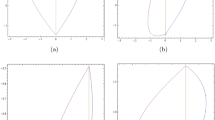Abstract
The techniques from singularity theory are applied to the multiparameter bifurcation problem. The classification of (D4, S1)-equivariant bifurcation problems with topological codimension less than or equal to 2 is given. The corresponding recognition conditions are set up.
Similar content being viewed by others
References
Golubitsky, M., Schaeffer, D. G., A theory for imperfect bifurcation via singularity theory, Commun. Pure Appl. Math., 1979, 32: 21–98.
Golubitsky, M., Schaeffer, D. G., Imperfect bifurcation in the presence of symmetry, Commun. Math. Phys., 1979, 67: 205–232.
Keyfitz, B. L., Classification of one state variable bifurcation problem up to codimension seven, Dyn. Stable Sys., 1986, 1: 1–42.
Golubitsky, M., Schaeffer, D. G., Singularities and Groups in Bifurcation Theory, Vol. 1, New York: Springer-Verlag, 1985.
Golubitsky, M., Roberts, M., A classification of degenerate Hopf Bifurcation with O(2) symmetry, J. Diff. Eqs., 1987, 69: 216–264.
Melbourne, I., The classification up to low codimension of bifurcation problems with octahedral symmetry, PhD Thesis, University of Warwick, 1988.
Manoel, M., Stewart, I., The classification of bifurcations with hidden symmetries, Proc. London Math. Soc., 2000, 80(3): 198–234.
Peters, M., Classification of two-parameter bifurcations, Lecture Notes in Math., Berlin, Heidelberg: Springer-Verlag, 1991, Vol. 1463: 294–300.
Furter, J. E., Sitta, A. M., Stewart, I., Singularity theory and equivariant bifurcation problems with parameter symmetry, Math Proc. of the Cambridge Philo. Soc., 1996, 120(3): 547–578.
Golubitsky, M., Stewart, I., Schaeffer, D. G., Singularities and Groups in Bifurcation Theory, Vol. 2., New York: Springer-Verlag, 1988.
Melbourne, I., The recognition problem for equivariant singularities, Nolinearity, 1988, 1: 215–240.
Li Yangcheng, The recognition of equivariant bifurcation problems, Science in China, Ser. A, 1996, 39(6): 604–612.
Damon, J., The unfolding and determinacy theorems for subgroups of A and K, Memoirs of the American Mathematics Society, 1984, 50(306): 1–88.
Author information
Authors and Affiliations
Corresponding author
Rights and permissions
About this article
Cite this article
Gao, S., Li, Y. Classification of (D4, S1)-equivariant bifurcation problems up to topological codimension 2. Sci. China Ser. A-Math. 46, 862–871 (2003). https://doi.org/10.1360/02ys0217
Received:
Issue Date:
DOI: https://doi.org/10.1360/02ys0217




